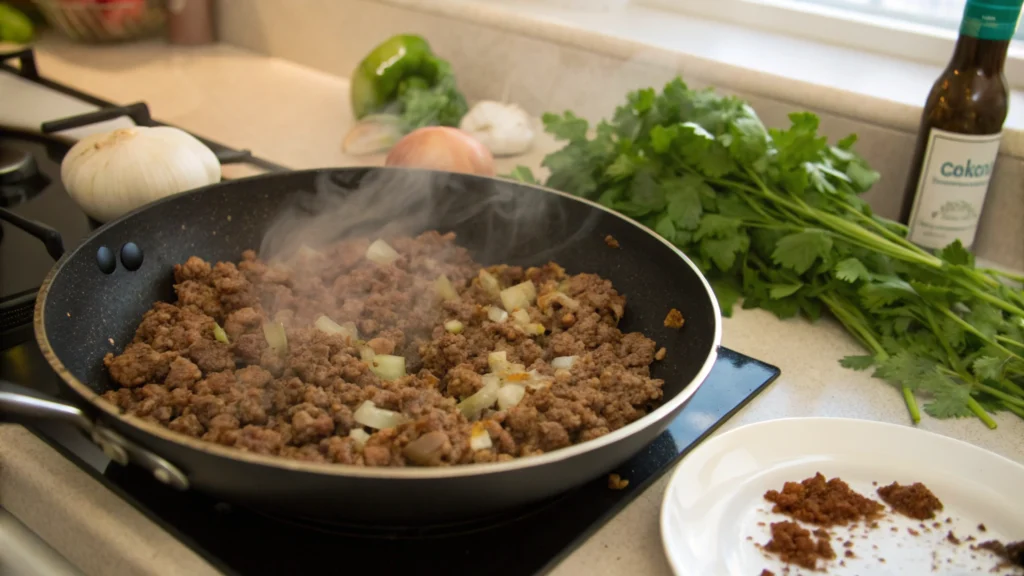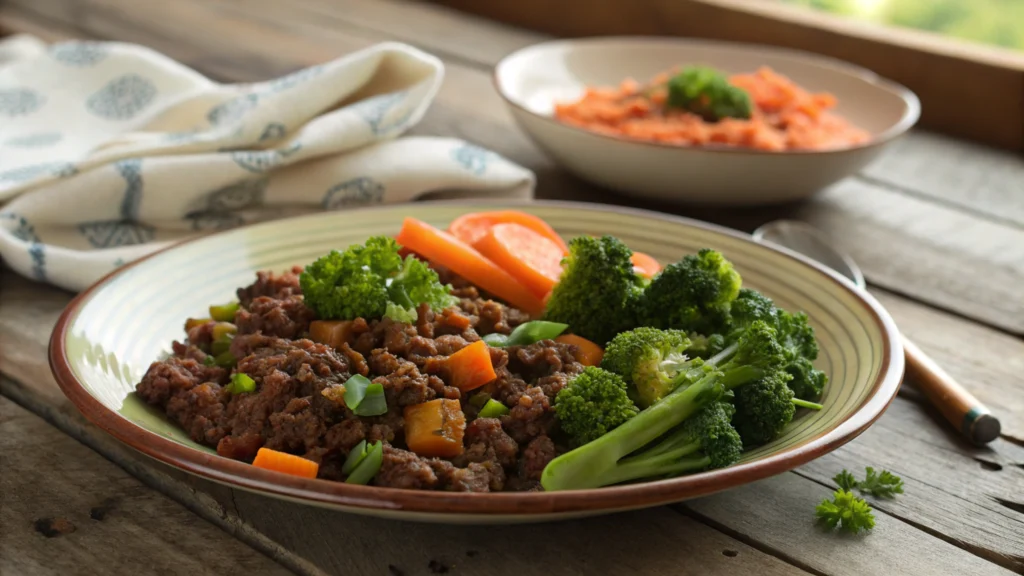Ground beef is an incredibly versatile ingredient found in various recipes, from savory hamburgers to the comforting meatloaf. However, beyond its culinary value, have you ever wondered about ground beef nutrition facts? This article will delve into the dietary details of ground beef, ranging from calories and protein content to its vitamins and minerals. Whether you’re trying to make better food choices or want to know more about the health benefits of this popular meat, we’ve got you covered. Let’s begin!
Ground beef isn’t simply a favorite for meals. When prepared properly and carefully, it’s also a powerful source of nutrition. This is a review of the reasons why the nutrition facts of ground beef are important to you.
What Makes Ground Beef a Staple in Many Diets?
Ground beef is prized because of its flavor, low cost, and versatility. From quick tacos to elaborate casseroles, it is prepared, seasoned, and used with nearly everything. What distinguishes it is its high nutrient content, which provides a substantial amount of Iron, protein, and other vital vitamins.
Understanding Ground Beef Labels: 80/20, 90/10, and More
Have you noticed the percentages on packages of ground beef? Labels such as 80/20 and 90/10 represent the proportion of lean meat to fat. For example, 80/20 ground beef is made up of 80 percent lean meat and 20 percent fat. This ratio significantly influences the ground beef nutrition facts, including its flavor, texture, calorie count, and fat percentage. Knowing how to interpret these labels can help you select the appropriate beef to meet your needs.
Why Ground Beef Nutrition Matters for Your Health
The nutritional profile of ground beef can be quite different depending on the fat content, cooking method, and portion size. It’s loaded with high-quality protein, vital for muscle repair, Iron to avoid anemia, and zinc to improve immunity. However, it may be very high in saturated fats, which makes portion control and cooking methods crucial to a healthy diet.
Detailed Nutritional Breakdown of Ground Beef
Ground beef is an essential ingredient for many home cooks. However, understanding its nutritional profile will help you make better choices. Let’s examine the calories, protein, fat, and micronutrients of this most loved food.
Calories and Macronutrients in Ground Beef
Ground beef’s calories broadly vary according to the fat content. For instance:
- 20/20 ground beef (80 percent lean and 20% fat) offers about 254 calories per 3 inches (85 grams) of cooked meat.
- Ground beef (93 percent lean and 7% fat) is about 173 calories in the same amount of food.
Ground beef also has a low amount of carbohydrates and is a high-quality protein supply. It’s a great filler option for ketogenic and low-carb diets.
Ground Beef Protein Content: How Much Protein Is in 100 Grams?
Ground beef is known for its protein content. A 100-gram portion typically has:
- Protein ranges from 21 to 26 grams according to the fat content. The protein is complete; that is, it contains the nine amino acids required for the repair of muscles and overall health.
Fat Content in Ground Beef: From Lean to High-Fat Options

Fat content varies significantly between types of ground beef:
- 80/20 Beef contains approximately 18g of fat in each serving, contributing to its flavor and richness.
- 93/7 beef contains just eight grams of fat, making it a less fat-laden option. Although fat can enhance flavor, it also boosts calories. To lower your saturated fat consumption, healthier alternatives are ideal.
Micronutrients in Ground Beef: Vitamins and Minerals Explained
Ground beef serves as a potent source of micronutrients that are essential, such as:
- Iron helps support the transport of oxygen in the blood.
- Zinc Zinc is essential for immunity function as well as wound healing.
- Vitamin B12 is essential for producing red blood cells and the brain’s health. It also contains lower amounts of selenium, niacin, and phosphorus. These are essential to a healthy diet.
Comparing Food By Fat Percentage: 80/20 vs. 90/10. 95/5
All ground beef is not produced equally. The ratio of lean meat versus fat directly affects its flavor, texture, and nutritional characteristics. Let’s take a look.
What Is 80/20 Ground Beef Nutrition?
80/20 ground beef contains:
- Calories: ~254 per 3 ounces
- Protein: 22 grams
- Fat: 18 grams (7 grams saturated fat)
This food is popular for meatballs and hamburgers because of its delicious, flavorful, and juicy texture.
Is Ground Beef High in Fat? Exploring the Variations
Here’s how fat content compares across standard options:
- 80/20: Higher in fat, significant for indulgent dishes.
- 90/10 A balanced balance between flavor and leanness.
- 95/5: Ultra-lean, ideal for calorie-conscious diets.
Lower-fat beef choices reduce calories and saturated fat consumption, which makes them a better option for heart health.
Best Uses for Each Type Based on Nutrition
- Beef that is 80/20 is great for grilling or frying, where fat is a great way to enhance the flavor.
- 90/10 beef is a versatile ingredient in its use for casseroles and sauces.
- 95/5 beef is ideal for chili, tacos, or other recipes that get flavor from spices.
For tasty recipes such as Ground Beef Bulgogi and Meatloaf using 1 lb of Ground Beef, explore similar articles on Flavory Cook and Meatloaf Recipes Using 1-2 lbs of Ground Beef. These recipes make the most of ground beef nutrition facts while delivering incredible flavor. Be sure to check back for our next section on the health benefits and cooking tips!
The Health Benefits of Ground Beef
Ground beef isn’t just about taste; it’s also quite powerful when it comes to nutritional value. If you’re looking for a nutritious, versatile protein to add to your menu, Ground beef may be the ideal choice.
It is a Source of High-Quality Protein
Protein is vital for the growth of muscles and the repair of tissues, as well as general energy. With between 22 and 26 grams of protein for 100 grams of ground beef, it is a top choice for those on high-protein diets. This protein is complete and contains all the essential amino acids your body requires. It is a good option for meals after a workout or as a primary ingredient in a balanced diet.
Rich in Iron, Zinc, and Vitamin B12
Ground beef can be an excellent food source for a variety of vital nutrients:
- Iron is around 2.3 mg for 3 ounces, which helps reduce anemia and boost the body’s energy level.
- Zinc supports immune function. There are around 5.4 mg per serving.
- Vitamin B12 is Vital for brain functioning and red blood cell development and formation; only three tablespoons provide 100% of the daily recommended intake.
These minerals make ground beef an excellent food for anyone of any age, especially those who need Iron, and they help improve overall immunity.
Is Ground Beef Healthy for You? Pros and Cons
The quality and health of ground beef are contingent on how it’s prepared and its fat content. Although lean ground beef is low in saturated fats and calories, the fattier cuts, such as the 80/20 grade, are rich in flavor and saturated fat. The balance is crucial! Select lighter cuts for everyday meals and fattier choices for occasions requiring bold flavors.
Healthy Ways to Prepare Ground Beef
When cooked properly, ground beef retains its nutritional benefits and fits perfectly into a healthy lifestyle. Let’s look at some clever methods of preparation.
Cooking Methods That Retain Nutritional Value

The method you use to cook ground beef is crucial. Choose these techniques to make your meals tasty and healthy:
- Grilling or Broiling: Let extra fat run off.
- Sauteing using minimal Oil: Reduces calories while also locking in the flavor.
- Steaming, boiling, or boiling is the best choice for those who want to be ultra-lean and a method to reduce the amount of fat.
Beware of deep-frying and heavy creams since these could obscure some of the nutritional information contained in ground beef.
How to Reduce Fat in Ground Beef Dishes
When you’re concerned about fat levels, you can take pleasure in your favorite recipes for ground beef using:
- Draining Fat: After browning, pour off excess fat.
- Blotting using paper Towels: Get rid of additional grease.
- Mixing with vegetables: Use grated carrots, zucchini, or mushrooms to add bulk to recipes without adding calories.
For example, you can look up the Healthy Breakfast Burrito Guide for a recipe that uses lean protein to give you an enjoyable beginning to your work day.
Recipes for Balanced Meals Using Ground Beef
The flavor of ground beef is evident in dishes in which spices and other ingredients provide richness. Here are some ideas:
- Ground Beef Chili Combine lean ground beef with tomatoes and beans for an incredibly fiber-rich dish.
- Stuffed bell peppers Mix lean meat, rice, and vegetables for a healthy, delicious, and flavorful meal.
- Slim-carb meals: Mix ground beef, avocado, and rice from cauliflower to make a healthy and nutritious option.
Explore recipes like ground beef Bulgogi, which balances nutrition and flavor perfectly for more tasty ideas.
Frequently Asked Questions
Inquiring about the nutritional value of ground beef often raises important questions regarding its health benefits and usage. Let’s dive into some of the most frequently asked questions about ground beef nutrition facts to help you make educated and informed decisions.
How Much Protein Is in 100 Grams ?
Ground beef is a great food source of protein. A 100-gram portion typically has between 21 and 26 grams of protein, contingent on the fat percentage. For example:
- Ground beef 80/20 About 22g of protein.
- Ground beef 93/7: A little higher in 24 grams due to less fat.
This is what makes ground meat a popular choice for fitness enthusiasts, athletes, or anyone who needs to boost their protein intake.
How Healthy Is Ground Beef?
How nutritious can you eat ground beef? It’s based on the kind you select and how you cook it. Better options, such as ground beef 90/10, are healthier options for meals that provide lots of protein but with lower saturated fat. The cooking methods you use to cook it are also important. Grilling or broiling can help reduce excess fat. Adding vegetables can boost the quantity of fiber and nutrients that you can incorporate into your meals.
For healthy and balanced dishes using ground beef, you could appreciate ideas like Healthy Breakfast Burritos or lighter recipes that include fresh vegetables.
What Is 80/20 Ground Beef Nutrition?
Ground beef 80/20 is made up of:
- Calories: ~254 per 3 ounces
- Protein: 22 grams
- Fat: 18 grams
This more fat-laden blend is great for meatballs and juicy burgers; however, it must be enjoyed with moderation if you’re paying attention to the amount of saturated fat you consume.
Is Ground Beef High in Protein?
Yes! Ground beef is a high-protein food source, supplying all the amino acids your body requires. When you’re cooking tacos or chili ground beef, it will help you achieve your protein goals effortlessly.

Ground Beef Nutrition in Popular Diets
Ground beef can be found in various popular diets, from keto to diets that are low in calories. Let’s see how it stacks up.
Is Ground Beef Keto-Friendly?
Absolutely! Ground beef is a popular choice among keto enthusiasts because it’s low in carbohydrates and high in fat and protein. Combining it with greens, avocado, or cauliflower rice makes an enticing meal that is in line with keto’s guidelines.
Ground Beef in High-Protein Diets: Benefits and Risks
If you’re a fan of a high-protein diet, ground beef is an excellent choice. It is a high-quality protein source that builds muscle and repairs. However, fattier cuts, such as 80/20 beef, may increase cholesterol levels if consumed too often. Choose leaner cuts, such as 93/7 beef, for the benefits but without the risk.
Ground Beef for Weight Loss: Does It Fit in a Calorie-Deficit Diet?
Yes, however, portion size and preparation are essential. To limit calories, select lean ground beef and nutrient-rich ingredients such as vegetables and whole grains. For example, bell peppers stuffed with ground beef and quinoa are healthy, calorie-conscious meals.
For additional delicious recipes and ideas to include ground beef in your diet, try recipes such as Ground Beef Bulgogi and Meatloaf using 1 lb of Ground Beef. These recipes strike the perfect balance of flavor and nutritional value.
Conclusion: Maximizing the Benefits of Ground Beef in Your Diet
Ground beef is more than an ingredient that can be used in various ways. It’s a nutritious protein suitable for virtually every diet, providing high-quality protein and vital vitamins such as B12 and Iron. It provides much more than can be seen from afar.
Why Understanding Ground Beef Nutrition Is Important
If you know the nutritional facts about ground beef and information, you’ll be able to make better choices to improve your health and eat healthier. If you’re trying to balance calories, reducing fat intake, or looking to boost your protein intake, knowing the nutritional differences between ground beef types is essential. For instance, selecting 90/10 ground beef over 80/20 is a great way to cut saturated fat without losing taste.
Making Informed Choices for a Balanced Diet
Ground beef is an excellent ingredient in many recipes, from keto-friendly low-carb bowls to high-protein chili. But the way you prepare it matters just as much as the type of beef you choose. By grilling, broiling, or draining excess fat, you can maximize the ground beef nutrition facts benefits without adding unnecessary calories or fat. Pairing ground beef with whole grains, vegetables, and healthy fats creates meals that are both flavorful and nutritious.
Look up recipes such as Ground Beef Bulgogi for ideas on how to maximize the use of ground beef. Or explore lighter alternatives with Healthy Breakfast Burritos.
Additional Resources
After delving into the nutritional facts about ground beef, you can integrate it into your daily diet. However, the journey doesn’t stop with this!
Explore Other Recipes Using Ground Beef.
The versatility of ground beef means there’s always a new recipe you can explore. If you’re looking for a hearty meatloaf, delicious stir-fries, savory savory dishes, or low-carb alternatives, There’s something for anyone. For example:
- Try Meatloaf using 1 lb of ground beef to make a classic comfort food.
- Try out international tastes such as ground Beef Bulgogi.
Learn More About Ground Beef Nutrition
Keep yourself informed about the foods you consume. Continue to learn more about the ground beef nutrition facts and how this versatile ingredient can fit your individual dietary requirements. Healthy eating is about understanding your food choices, and ground beef is a perfect example of an ingredient that can be both tasty and nutritious.
Armed with the nutritional facts you’ve learned here, you’re now able to indulge in this delicious staple in a healthy and delicious way. If you’re planning your next meal with the family or preparing for the week, ground beef could be an essential ingredient with the appropriate preparation and mindful decisions.


5 thoughts on “Ground Beef Nutrition Facts: Guide to Healthier Choices”